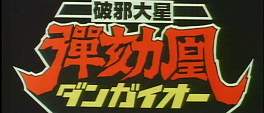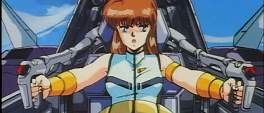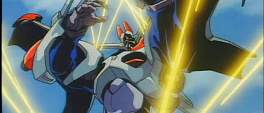This is the second part of my dive into some of the anime that I watched during my adolescence in the wee hours of analogue satellite stations. The first part concerned the ultraviolent Genocyber.
When I began my project to relive my formative anime experience, I was looking for a series that had a very specific scene. The only reason I can remember it vividly was not the anime itself but more what happened around it. Suffice to say, Dangaioh was not the series I was looking for, and despite my memory assuring me I had watched it, very little jogged my memory (this could be to do with Manga Entertainment only released two out of three episodes). Much of that familiar feeling though can be attributed to how trend setting Dangaioh was for its time period, something that mecha design and sci-fi series in general would mimic and cherry pick from in the years to come.
The series of three OVAs kicks off the action immediately with the four protagonists, three females and one male, attacked by robots and told the planetoid they are on will explode unless they escape. There is no protracted learning of their powers which they all use in short order to survive and, as openings go, its allure is in its immediacy. From there it's an adventure story as the group are summarily imprisoned only to escape and track down each of their forgotten pasts using the fighting machine Dangaioh - which naturally comes forth from the combination of four space craft and fighting spirit.
What is most telling of the series is not how quickly it clips through the protagonists back stories, but how well directed the entire production is. There is rarely poor framing or a boring shot, with even the perfunctory talking heads leant some inventiveness. This somewhat makes up for a plot which is over far too quickly and inconclusive when it comes to the more overbearing antagonist as well as the whininess of protagonist Mia who squeals and agonises over every decision.
Many elements can be laughed off as symptomatic of their time period - the girls all in skimpy swimwear even in Arctic conditions (Gene Roddenberry was a huge proponent of this mentality), the male of the group being key to the unification of the Dangaioh, or the necessary decimation of Tokyo; all are present but don't detract from an otherwise remarkably entertaining production. Unfortunately, beyond the sporadic action, there is little else that is memorable. Whether for better or worse, mecha focused series have grown and mutated since Dangaioh and grander plots, deeper characters and more intense combat have all been achieved.
For pulpy and instant gratification, the series ticks all the right boxes: bright, colourful, detailed and slick the visuals leave little to be desired. Pleasingly unpretentious as to who it is aimed at and what it ultimately tries to achieve, the occasional symbolism such as the angelic halos above the girls' pilot seats can be attributed more as accidental than intentional. Burn with fighting spirit, shout the names of your attacks and vanquish the villain with more resurrections than a Marvel antagonist and you have Dangaioh.
Where are they now?
To talk of Dangaioh is primarily to talk about the esteemed luminaries that were part of its production. Director Toshiki Hirano performed similar duties on series such as Magic Knight Rayearth, Vampire Princess Miyu and Devilman Lady as well as taking up a character design position on Megazone 23 and the lamentably poor Dangaioh sequel, Great Dangaioh. The job of animation director was handed to Masami Obari who went on to direct the erotic OVA Angel Blade and the similarly raunchy Gravion, but was also involved in other mecha shows such as Platinumhugen Ordian and Detonator Orgun, but was also an animator for the sublime Gunbuster.
Which naturally brings up Hideaki Anno who provided key animation for Dangaioh but of course went on to found GAINAX and produce Gunbuster, Evangelion and so many other transcendental productions. Interestingly, Anno had already set up GAINAX (1984) and released Gunbuster shortly after the first OVA release of Dangaioh which made it a doubly good year for mecha fans.
Speaking of which, perhaps one of the most well known of mecha designers, Shoji Kawamori was present and correct for Dangaioh. Expanding an already brilliant career that encompassed Macross and would go on to incorporate designs in Eureka Seven, Escaflowne, Patlabor, Ghost in the Shell, Aquarion as well as the Armored Core series of video games and Transformers cartoon series. Kawamori's influence is immense and elements of his designs can be seen across the spectrum of anime, with hooks in most modern mecha productions, including powerhouses such as Code Geass or Tengen Toppa Gurren Lagann.
It would of course be unfair not to mention Koichi Ohata who was deeply involved with Dangaioh with the screenplay, storyboards and animation and went on to direct the previously mentioned Genocyber. Like that show Artmic was involved with production, however it was AIC (Anime International Company) who are widely attributed with the bulk of the production and is still in full swing with recent shows such as Asobi ni Iku Yo! and the second season of Strike Witches.
Dangaioh holds more reverence for mecha fans than it perhaps does for others. Kawamori is often held in very high regard, his name uttered alongside greats such as Hajime Katoki (Gundam, Patlabor, Super Robot Wars, Virtual On) and even Yoshiyuki Tomino (Gundam) so it is hard to understate their personal contributions. It is difficult to discern whether Dangaioh itself had an affect on future series, or whether it was symptomatic of the way many similarly pitched productions were going. Regardless, as a time capsule of the era - late eighties early nineties - it sits alongside many highly regarded names.











